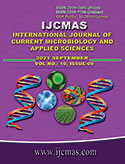


 National Academy of Agricultural Sciences (NAAS)
National Academy of Agricultural Sciences (NAAS)

|
PRINT ISSN : 2319-7692
Online ISSN : 2319-7706 Issues : 12 per year Publisher : Excellent Publishers Email : editorijcmas@gmail.com / submit@ijcmas.com Editor-in-chief: Dr.M.Prakash Index Copernicus ICV 2018: 95.39 NAAS RATING 2020: 5.38 |
Papaya fruit disease has not been known with certainty the cause of the disease, and until now the appropriate control strategy has not been determined. The results of microscopic identification of rot disease in papaya fruit caused by the fungus Lasiodiplodia theobromae. The most exophytic fungi found in the study were Rhizopus sp. as many as 69 isolates, followed by Aspergillus niger as many as 6 isolates, only Actinomyces israelii only 6 isolates while the other Actinomycetes (Actinomadura cremea, Streptomeces sp., and Micromonospora sp.) each had one isolate. While the endophytic fungi were found Rhizopus sp. as many as 30 isolates, followed by A. niger with 18 isolates, and finally Agromyces ramosus (Actinomycetes) and Trichoderma sp, each with 3 isolates. The highest prevalence was obtained from the fungus Rhizopus sp. The diversity index and the dominance index on exophytic microbes were 2.45 and 0.4078, respectively. The index of diversity and dominance of endophytic microbes were 1.876 and 0.58, respectively. The results of the analysis of the inhibitory power of exophytic and endophytic microbes in vitro, it turns out that almost all have competitive inhibition as well as Trichoderma sp. which has a zone of inhibition means that it is antibiotic and also competitive. Most Actinomycetes have no inhibitory power against pathogens (L.theobromae). The results of the in vivo inhibition test showed that the highest and best inhibitory power was obtained from treatment E (Trichoderma sp.).
 |
 |
 |
 |
 |